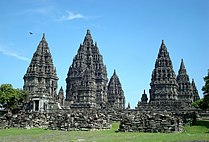| Part of a series on |
| Hinduism |
|---|
 |
The history of Hinduism covers a wide variety of related religious traditions native to the Indian subcontinent.[1] It overlaps or coincides with the development of religion in the Indian subcontinent since the Iron Age, with some of its traditions tracing back to prehistoric religions such as those of the Bronze Age Indus Valley Civilisation. Hinduism has been called the "oldest religion" in the world,[a] but scholars regard Hinduism as a relatively recent synthesis[2][3][4] of various Indian cultures and traditions,[2][3][5] with diverse roots[6] and no single founder,[7][b] which emerged around the beginning of the Common Era.[8][c]
The history of Hinduism is often divided into periods of development. The first period is the pre-Vedic period, which includes the Indus Valley Civilization and local pre-historic religions. Northern India had the Vedic period with the introduction of the historical Vedic religion (sometimes called Vedic Hinduism or ancient Hinduism[d]) by the Indo-Aryan migrations, starting somewhere between 1900 BCE and 1400 BCE.[9][note 1] The subsequent period of the second urbanisation (600-200 BCE) is a formative period for Hinduism, Jainism and Buddhism, followed by "a turning point between the Vedic religion and Hindu religions,"[12] during the Epic and Early Puranic period (c. 200 BCE to 500 CE), when the Epics and the first Purānas were composed.[3][13] This was followed by the classical "Golden Age" of Hinduism (c. 320–650 CE), which coincides with the Gupta Empire. In this period the six branches of Hindu philosophy evolved, namely, Samkhya, Yoga, Nyaya, Vaisheshika, Mīmāṃsā, and Vedānta. Monotheistic sects like Shaivism and Vaishnavism developed during this same period through the Bhakti movement. It flourished in the medieval period period from roughly 650 to 1100 CE, which forms the late Classical period[14] or early Middle Ages, with the decline of Buddhism in India[15] and the establishment of classical Puranic Hinduism is established.
Hinduism under both Hindu and Islamic rulers from c. 1200 to 1750 CE[16][17] saw the increasing prominence of the Bhakti movement, which remains influential today. Adi Shankara became glorified as the main proponent of Advaita Vedanta, in response to the success of Vaishnavite bhakti.
The colonial period saw the emergence of various Hindu reform movements partly inspired by western movements, such as Unitarianism and Theosophy. The Partition of India in 1947 was along religious lines, with the Republic of India emerging with a Hindu majority. During the 20th century, due to the Indian diaspora, Hindu minorities have formed in all continents, with the largest communities in absolute numbers in the United States and the United Kingdom.
- ^ Brodd 2003.
- ^ a b Lockard 2007, p. 50.
- ^ a b c Hiltebeitel 2007, p. 12.
- ^ Samuel 2010, p. 193.
- ^ Flood 1996, p. 16.
- ^ Narayanan 2009, p. 11.
- ^ Osborne 2005, p. 9.
- ^ Welbon 2004.
- ^ Michaels 2004, pp. 32–36.
- ^ Witzel 1995, pp. 3–4.
- ^ Flood 1996, p. 21.
- ^ Michaels 2004, p. 38.
- ^ Larson 2009.
- ^ Michaels 2004.
- ^ Larson 1995, pp. 109–111.
- ^ Stein 2010, p. 107.
- ^ Tripathi, Ram Prasad (1956). Some Aspects of Muslim Administration. Central Book Depot. p. 24. Archived from the original on 14 November 2023. Retrieved 23 December 2023.
Cite error: There are <ref group=lower-alpha> tags or {{efn}} templates on this page, but the references will not show without a {{reflist|group=lower-alpha}} template or {{notelist}} template (see the help page).
Cite error: There are <ref group=note> tags on this page, but the references will not show without a {{reflist|group=note}} template (see the help page).




